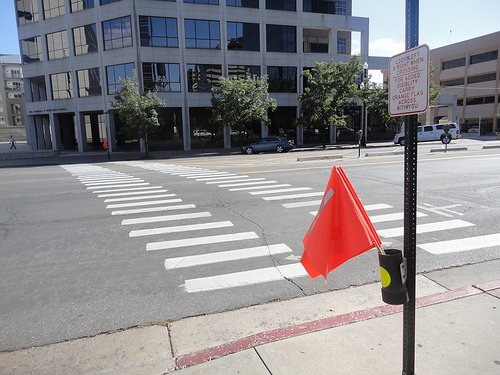The road to pedestrian hell is paved with good intentions — and lined with brightly colored flags. Bridgeport, Conn., is the latest American city to institute a pedestrian flag system at one of its downtown intersections. The concept is easy to grasp: Pedestrians grab a flag from a post and wave it as they cross from one side of the road to the other, capturing the attention of oncoming drivers. As the city’s police chief explains to Treehugger, “Our police officers are out every day enforcing our traffic laws and working to keep our streets safe. But motorists are just part of the formula. In my mind, it will be worth it if this project prevents one injury or death.”

At some point in the past, a tragic set of decisions led to this pathetic stretch of concretized car pasture. If you see this in your town, it’s OK to ask your mayor some tough questions about his or her planners’ qualifications. Image from Paul Sableman.
Kirkland, Washington was one of the system’s early adopters. In 1995, the city developed its PedFlag program, on the suggestion of a resident who had heard about the concept’s use in Japan. Today, Kirkland has outfitted 73 locations with bright pedestrian flags, and claims that the program is effective. As the city’s website explains, “This is a device that is low in cost and can be installed for pedestrian use in a timely manner. Once the equipment is installed at the crossing, the only ongoing cost is the replacement of the flags. Depending on the location and season, it can be zero to five flags a week.”
Salt Lake City instituted flags in 2000 at a selection of crosswalks, reports Wired. Some of the flags were sponsored by local businesses, schools and residents. Today there are 100 crosswalks in the city manned with pedestrian flags. Last year, Metuchen, N.J., instituted a flag program that has since expanded to two intersections, and , first introduced the idea in 2007. Smaller cities throughout the country have adopted the idea, including Port Washington, Wisconsin, and McCall, Idaho.
But other cities haven’t had such luck with the program: Berkeley, California invested in a flag program at seven intersections, but found that only two percent of pedestrians used the flags properly. Flag theft was proved to be a major obstacle, and, most significantly, a woman carrying a flag was hit by a car — though not seriously injured — within one week of the program’s onset. Seattle, Washington ran a pedestrian flag program at 17 intersections but ended it in 2008, discovering that “there was not a consistent pattern of improved compliance observed, and some locations were not able to be evaluated due to frequent theft of the flags.”
As 2010 data from the CDC points out, one pedestrian is killed in a car crash every two hours, and one pedestrian is injured in a crash every eight minutes. Proponents argue that the flag system is a low-cost way to boost pedestrian safety (except, of course, in the case of Berkeley, which sunk $10,000 and 8,000 flags into their failed program). But what does it say about a city’s car culture when the average pedestrian is forced to take on the role of traffic cop?